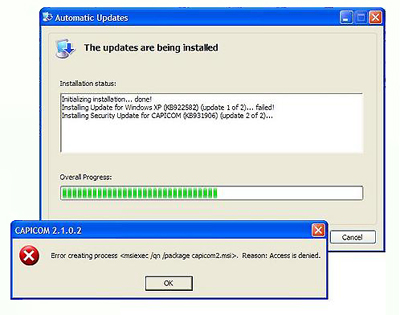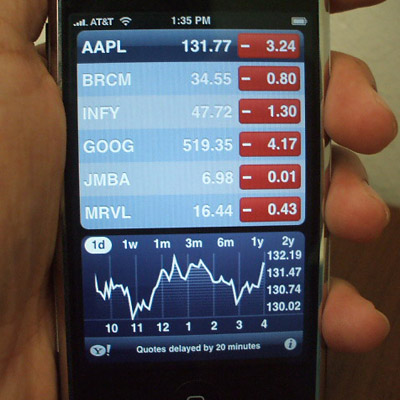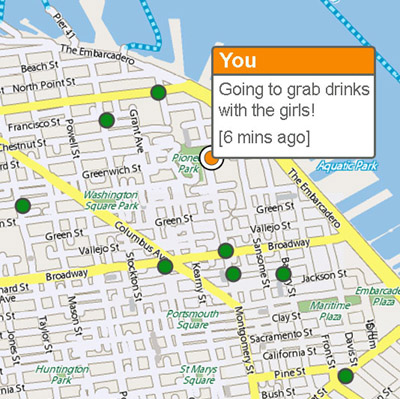Jun 18, 2008
When Invention Outpaces Necessity: Technosocial Cause & Effect
I was talking to a friend of mine last night about the pros and cons of Macs versus PCs. Macs are unified and (relatively) hassle free, but rigid. PCs, on the other hand, offer greater flexibility and a lower price point, but because they’re run on hardware and software pulled together from dozens if not hundreds of sources, in Frankensteinian fashion, and haphazardly cobbled together using eristical standards, everything doesn’t always work together the way it should.
 One of the problems my friend was complaining about was the colicky way Vista requires constant attention: “An update is now available. Would you like to download it now?” “The version you are running is out of date. Some items may not display properly.” “Windows cannot open this file. What do you want to do?: Use the Web service to find the appropriate program / Select the program from a list.” You get the point. Nothing works properly for any amount of time without your being notified and asked to download or install some new program or update or patch. As OSs and applications become more and more complicated and integrated into networked functions, it’s only going to get worse. It’s enough to drive anyone into the waiting arms of a Mac without a second thought.
One of the problems my friend was complaining about was the colicky way Vista requires constant attention: “An update is now available. Would you like to download it now?” “The version you are running is out of date. Some items may not display properly.” “Windows cannot open this file. What do you want to do?: Use the Web service to find the appropriate program / Select the program from a list.” You get the point. Nothing works properly for any amount of time without your being notified and asked to download or install some new program or update or patch. As OSs and applications become more and more complicated and integrated into networked functions, it’s only going to get worse. It’s enough to drive anyone into the waiting arms of a Mac without a second thought.
There’s a solution to the problem, of course. It’s a trend that started a few years ago and has been growing increasingly popular. Basically, it involves taking the program you run on your computer and running it on the Internet instead. Applications like accounting programs were among the first to make the move, and it makes sense: accounting programs require constant updates, often need to network many users together, and are generally pretty complicated. Even installing the program on your computers from CD and updating your settings can take a long time, and then a year later you have to go through it all again. What if instead of installing the program on your computer, you just used a web-based service — what if you used Firefox or IE to log on to a website where all your accounting information was stored, accessible from any Internet connection at any time, and you never had to worry about installing or updating the software?
It’s no wonder this is such a popular option. Instead of updating the myriad of applications you run on your computer, you only have to update one: your web browser. Through that, you can access hundreds of applications online. Software companies prefer it too; once you’ve bought a program once, they can only hope and pray that you choose to keep upgrading. As a good friend of mine, Tiffany Conroy, wrote: “Software companies no longer need to get you to buy the software once and hope you find a need for an upgrade. Instead you pay a subscription fee … and the software is upgraded all the time. No need to support legacy versions, no need to market to existing customers all the flashy new features and no distribution/packaging costs. (There are other costs of course, like running the data center, but those factors are things much more controllable.)”
Tiffany also suggested to me that there’s really no limit to how much processing can be moved online. In fact, she goes so far as to say that the idea of a discrete “browser” running on your computer which allows you to access the Internet will soon disappear (along with all your other programs); your computer will do no “local” processing, and will become merely a system that allows you to access whatever programs you want to run on the web. Your browser and your OS essentially merge into a single system; your OS will be good for only one thing — running server-based programming. There’s a name for this: a thin client — as opposed to a thick client, which is a computer running all sorts of local processes. The more processing you move online and simply access from your computer, the thinner your client.
 If you think that sounds a little like the iPhone, you’re not alone: Tiffany forwarded this article from antikoan.net. The author argues that the iPhone and other mobile Internet handsets are really “web 2.0 terminals;” as much as the phrase “web 2.0” makes me cringe, I think the word “terminal” perfectly captures the spirit of the device and what it’s for — it’s a point of access into the infosphere, in the same way an ATM is a terminal that lets you access your bank account. Except now you can access your bank account on a mobile handset too. The only thing it can’t do it spit out cash.
If you think that sounds a little like the iPhone, you’re not alone: Tiffany forwarded this article from antikoan.net. The author argues that the iPhone and other mobile Internet handsets are really “web 2.0 terminals;” as much as the phrase “web 2.0” makes me cringe, I think the word “terminal” perfectly captures the spirit of the device and what it’s for — it’s a point of access into the infosphere, in the same way an ATM is a terminal that lets you access your bank account. Except now you can access your bank account on a mobile handset too. The only thing it can’t do it spit out cash.
The author of the above link also suggests that thin clients are experiencing a second wind — that they were written off as unfeasible, but the model has since changed to the point that technological impediments have been overcome, and new revenue streams have been tapped. That’s certainly the logic behind the iPhone and the Android platform: service provider fees aside, the real revenue is in advertising and charging people for both applications and content.
Tiffany advanced one final theory to me: “social behaviour and tastes adapt to match capabilities of technology, rather than the other way around.” In my post on Android, I described how Google’s platform (whether on a Mac, a PC, or a mobile handset) is designed to allow for the easier flow of data between applications, and mentioned Apple’s similar model. This interconnectedness demands that these applications run on the web, because nothing else can satisfy the requirements of moving bits of data from one app to another. But the way in which we take advantage of this interconnectedness isn’t necessarily an extension of increased functionality.
This example I wrote about earlier, where Google will send you an Email with a link to a map to your destination, would be literally impossible to achieve on a thick client. Even supposing your calendar could send you a notification, it would never be able to provide a map to your destination, for the simple fact that a maps application could never run on a thick client. Not only would it require far more memory than the average computer could provide in order to be useful, but it would also require constant updates. Google maps (among others) has records of virtually every street address on Earth! Try fitting that on your PC, let alone your cellphone. Remember the 90s, when we were told that one day we’d be able to fit all of Shakespeare’s works on a single CD? Even then, nobody foresaw fitting complex applications like an interactive map of virtually every street on Earth onto a single CD. Well, as it turns out, CDs are pretty redundant when you can just go online and get the information anytime. And complex applications are the tip of the iceberg — it’s interconnected applications that can really only thrive online.
 There was a moment in the demonstration of the new iPhone where the developer of an application called Loopt shows off how he can scan the GPS network to find friends in the neighbourhood — a quick call or text message and they can choose a nearby place to meet. “You never have to eat lunch alone again!” It’s remarkable that this gets applause, considering this is an application that — at least among my peers — there was no demand for; invention is now the stepmother of necessity. The increased functionality of networked applications makes certain tasks easier, but it also leads to certain actions on the part of the user that are not necessarily functional. Facebook is popular, but did it meet a need? Is its success based on fulfilling a demand or creating a solution to a problem? Or did we create the need in response to increased interconnectivity?
There was a moment in the demonstration of the new iPhone where the developer of an application called Loopt shows off how he can scan the GPS network to find friends in the neighbourhood — a quick call or text message and they can choose a nearby place to meet. “You never have to eat lunch alone again!” It’s remarkable that this gets applause, considering this is an application that — at least among my peers — there was no demand for; invention is now the stepmother of necessity. The increased functionality of networked applications makes certain tasks easier, but it also leads to certain actions on the part of the user that are not necessarily functional. Facebook is popular, but did it meet a need? Is its success based on fulfilling a demand or creating a solution to a problem? Or did we create the need in response to increased interconnectivity?
I considered writing this entry as two posts — one about programming moving online and rescuing PCs from the neverending drugery of constant maintenance, and another about how the resulting connectivity results in increased technosocial interactivity, and not the other way around. But the two are really in interplay; if the software we run was not required to communicate with other bits of software to work properly, it wouldn’t make sense to move your processes online — but if processes weren’t moving online, we wouldn’t be devouring networking applications the way we are.
Interactive maps aside, most of the bells and whistles the new generation of mobile handsets offers (like being able to take and instantly upload pictures to the Internet, playing chess in realtime with friends on different continents, locating friends in your vicinity, or having extended SMS chats while riding the bus) — while wonderful, and sure to be popular — are themselves setting a trend, not following one. They don’t fill a need so much as create one, but the explosive potentiality of networked web applications couldn’t help but exceed the uses people were about to readily incorporate into their lives. I don’t think it’s appropriate to view these applications in terms of need, however, but in terms of enhancement. Perhaps they don’t solve problems, but they can definitely find use in enriching the interactions we have with others, and even in simplifying many of the tasks we perform daily.
The patterns of movement of data are changing drastically, and becoming more and more complex. A system that simplifies the ways in which information is processed is obviously wonderful, but what’s interesting from a cultural point of view is the way in which the alterations to the patterns of data management in turn affect the patterns of human interaction.

The moment where the light went on in my head that the iPhone might be a thin client (Tiffany forwarded that link in response to a direct question) was as I was reading about the iPhone’s push functions. Obviously memory is limited on the iPhone, so running (for example) an eBay auction in the background is bound to eat up a lot of compute cycles, ha ha. Instead, your phone ceases to process anything, but Apple’s profile for you, running on some remote server, continues to run the auction site. When you need to place a bid, Apple sends your iPhone a notification, and at that point, you switch over to eBay and log back on.
That’s just one example; any background task you care to run can be assigned to your profile, and will not run on your iPhone. You’ll be notified when something changes, though, meaning your access to updated information isn’t compromised.
O. M. G.
I just wanted that Loopt video you linked. I’m super excited about that app. Like, truly. I love that idea. Wow.
Too bad all my friends live in another country, huh?
Funny Freudian. I said “wanted” when I meant “watched”
“Except now you can access your bank account on a mobile handset too. The only thing it can’t do it spit out cash.”
Who needs cash when you have the phone:
http://news.bbc.co.uk/2/hi/technology/6400217.stm
Yeah … I thought about pointing out that cash is becoming obsolete too …. Apparently people have been buying stuff using their cellphones in Japan for some time. And what’s really remarkable about that is the extremely low incidence of fraud and theft — the difference between stealing a phone and stealing a wallet is a thief can’t get the cash out of a phone.
For the record, Android has an app very much like Loopt coming out … it’s called “Commandro” and works pretty much the same.
http://commandro.net/